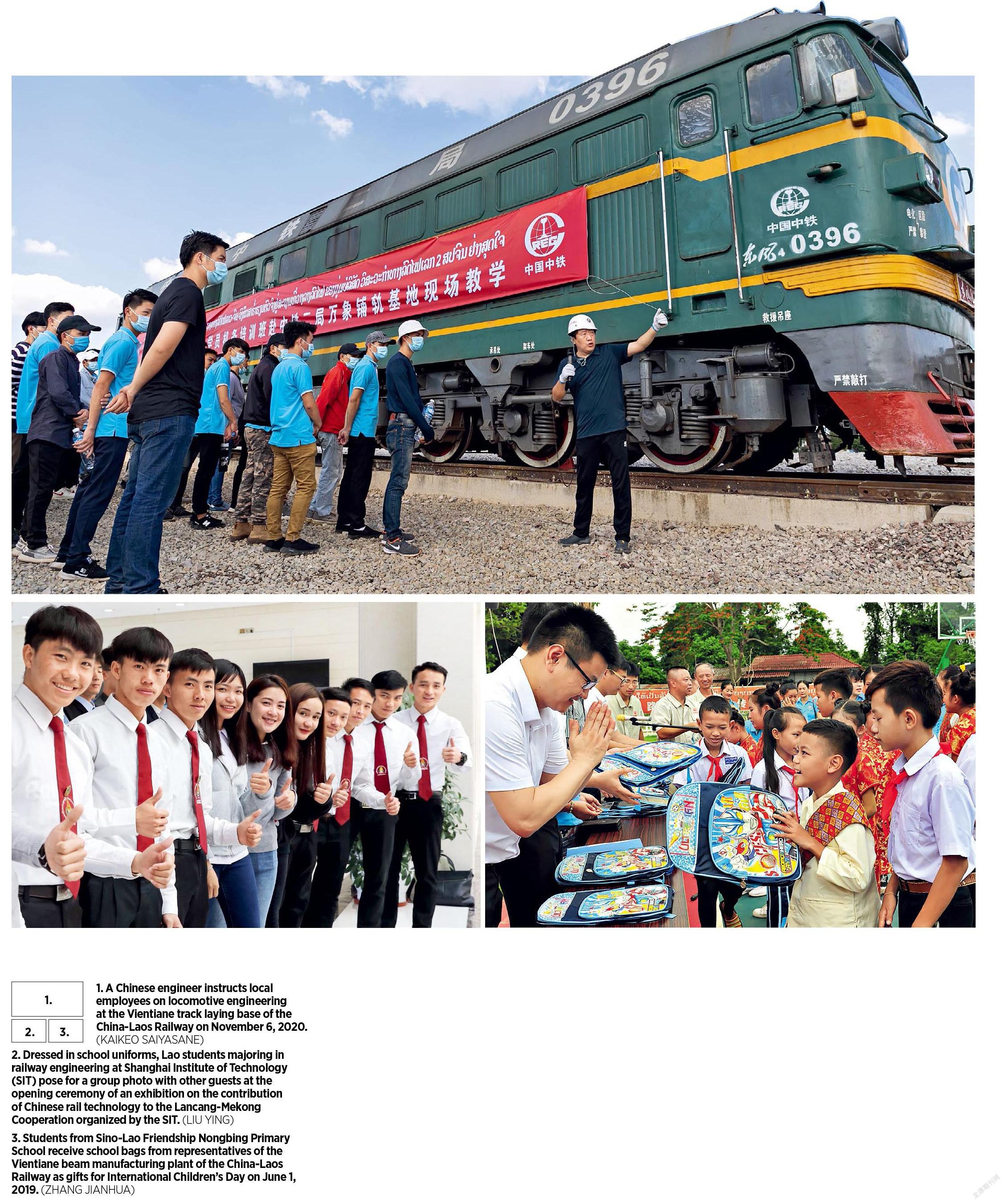COMMON RAILS TO PROSPERITY
2021-09-13


On December 2, Song Chaos excitement for the opening of the China-Laos Railway peaked. Despite his Chinese name, Song is Laotian. He works as an interpreter for the railway project and has been studying Chinas railway engineering technology during his spare time.
Song considers the project team like a family. “Everyone, Lao and Chinese alike, has been working conscientiously,” he said. “Management is compassionate. When it rains, they let us leave early and lend us raincoats.”
Many local Lao people have been recruited to help with construction of the China-Laos Railway. The Chinese construction team launched special training sessions to equip them with technologies and skills related to railway construction and management. Every participating worker wasprovided with an ID card, whichboosted their pride as employees of the railway project.
Foot in the Door
ThaomaekXai Za Wan is the headof a village along the Boten-Vientianesection of the China-Laos Railway.He is also a local Lao employee of theChina Railway International Group, the builder of the section.
“I applied for the job as soon as Iheard the news,”Thaomaekrecalled.“Construction of the railway created a job for me and enabled me tocontribute to my community.”
His job was to maintain a road paved through his village to serve the project. With a total length of 10 kilometers,the road enabled transportation ofbuilding supplies for a tunnel and twobridges. The transportation volumewas huge, demanding high standardsfor road maintenance. Thaomaekquickly became dedicated to the job.He patrolled the road several times aday and repaired any damage uponspotting it. Thanks to his work, the road withstood a devastating flood in 2018 and ensured continuous construction.
“Construction of the railway produced a great job for me,”said Thaomaek.“The Chinesetechnicians impressed me with theirprofessionalism and made me eager to contribute to the railway.”His work was recognized with the award of“RailwayArtisan”by the construction team.
Tobi Kang Omsa is a 35-year-old Laoscaffolder at the Muang Xai station.When he first started the job, he couldnever get the scaffolding perfectlylevel. The project team frequentlyasked him to dismantle and rebuild the scaffolding. At first, he was annoyed by the orders to redo all the work, but thesafety manager was patient. He showed Omsa how to make the scaffoldinglevel and helped him understandthe potential risks of improperscaffolding and the importance ofdoing things right. Omsa made thenecessary corrections and evolved into a proficient scaffolder. He now trainsincoming scaffolders.
More than 900 Lao workers wereinvolved in construction of railwaystations along the China-Laos Railwayin Laos. The construction team sentthe best technicians and engineers totutor Lao workers while working inkey positions. Through face-to-faceteaching, local workers mastered keyskills for every stage of constructionand will be able to maintain the railway and stations after the constructionteam leaves.
Thriving Lives
Localization has been a priority ofconstruction of the Boten-Vientianesection of the China-Laos Railway.While creating jobs for local people, the construction team organized myriadtraining sessions for local employeesand helped many with career growth.
“Lao Li,”25, is from underdeveloped Phongsaly Province in north Laos.He came to Oudomxay Province specifically seeking a job with the railway construction team.
Lao Li cherishes the job very much. Mentoring from a senior engineerhelped him become proficient atconstruction basics and emerge as ateam leader for smaller projects. He is satisfied with the stable income thejob provides.“I have two children,”herevealed.“They count on me. Whileearning income, I picked up a new skill. My life will get better and better.”Aftermany months on the job, the youngman was able to buy a new apartmentin Muang Xai, provincial capital ofOudomxay, and his family moved intothe new home.
Lao Li is one of many local workers who brought an entire family out ofpoverty through working with theconstruction team. The stable incomeenabled some to purchase property and some to build new houses while others used the new financial standing to start a family. Alongside the income, another benefit of the railway has been skillsmastered by local people, creating thepossibility of a new, more successfulcareer.
During the five years of construction, the railway witnessed the birth andgrowth of an education programjointly launched by Shanghai Instituteof Technology and SouphanouvongUniversity. Thanks to the coordination by the construction team, many Laostudents came to China to study.The construction team also offeredfinancial support to poor Lao studentsseeking to learn Chinese.
Li Guoyan, 19, hails from aHani family in Laos. She worksas an interpreter for the railwayconstruction team at the Muang Xai station. Her work has made it much easier for Chinese and Lao builders to communicate, and she saved theChinese workers considerable timeand energy dealing with entry and exit documents.
In her free time, she learned howto use a computer from her Chinesecolleagues. Next year, she will takethe China-Laos Railway to Xiamen on Chinas southeastern coast to attendcollege.
Star is a member of the logisticalcrew serving the construction team. Her daughter, a high school student, wasalready planning to attend college inChina. Stars Chinese colleagues helped her find a way to send her daughter toChina through the Confucius Institutein Luang Prabang. They also took turns tutoring her daughter in Chinese afterwork.
Another day, Star walked into theproject managers office with her heart racing with anxiety. She asked for aone-month wage advance because her father was ill in hospital. The manager agreed to give her the advance andeven offered another half-months pay as consolation money.“Thank you so much, my Chinese friend,”said Starwith gratitude.
While strengthening China-Laosfriendship, the China-Laos Railway has witnessed many romances betweenChinese and Lao people. XiongYinghao and ManichanDuangman met and fell in love while working on the railway.
On May 20, 2018, the couple gotengaged at Duangmans home. Theengagement ceremony was presidedover by a venerable figure from thegirls hometown and witnessed bycolleagues and her family and friends.
Xiong, 32, was sent by China Railway No.2 Engineering Group to join theconstruction team in Laos. Duangman, 24, was recruited as an interpreterfor the construction team in October2017. Their offices were adjacent.After learning about their conditions,their colleagues created opportunitiesfor them to get to know each other.The pair hit it off immediately, and aromance soon began.
An opportunity to celebrate arrived just as the couple was about to makethe relationship official. Sponsoredby the construction team, Duangman and her coworkers traveled to Chinafor a celebration hosted by a partnercompany. Duangman visited Xiongsparents, who were very satisfied with their future daughter-in-law.
Road to Happiness
“The railroad is a road of friendship between China and Laos and a roadto happiness for the villagers,”saidSongthongXaiyavong, head of BangLadhan Village.
Bang Ladhan Village in Oudomxay Province hosts the bulk of a bridgeover the Mekong River as part ofthe China-Laos Railway project. Thebridge was built by China RailwayNo.8 Engineering Group (CREC-8).Local residents recognized roads asa symbol of wealth because only richvillages could build roads. Beforethe construction team from CREC-8. arrived, the villagers had relied heavily on canoes for transportation forgenerations. A trail led to downtown,but it was in poor condition. It tookpeople from peripheral areas an entire day to reach the village center. A well- paved road to reach the outside world had been the most urgent desireshared by villagers.
In late 2016 when a section of theChina-Laos Railway broke groundaround the village, the constructionteam paved a 30-kilometer road tothe village. Winding through themountains, the road shortened traveltime from the village to Luang Prabang to merely an hour by car.
However, the roads inside the village remained dilapidated. More than 10truckloads of concrete were needed topave the two kilometers of village roads. When other expenses were calculated,the total cost exceeded 100,000 yuan,a whopping sum to local villagers whosurvived through farming.
With local wishes in mind, CREC- 8 organized technicians and specialequipment to renovate the villageroads. As the news spread, nearly allvillagers joined the construction teamdespite the scorching heat. After 10hours of efforts, all 802 villagers in 171 households became able to travel much easier.
While building the China-LaosRailway, construction teams helped villages along the railway renovatewater facilities, build bridges, andpave rural roads and schoolyards.Infrastructure for Lao residents has been gradually improving, and their lives are also getting better.
“We are not only building a tunneland a bridge, but also representing thestandards of Chinese engineering and enhancing China-Laos friendship,”said one construction worker.“It is our responsibility to build this railway atthe highest standards.”
